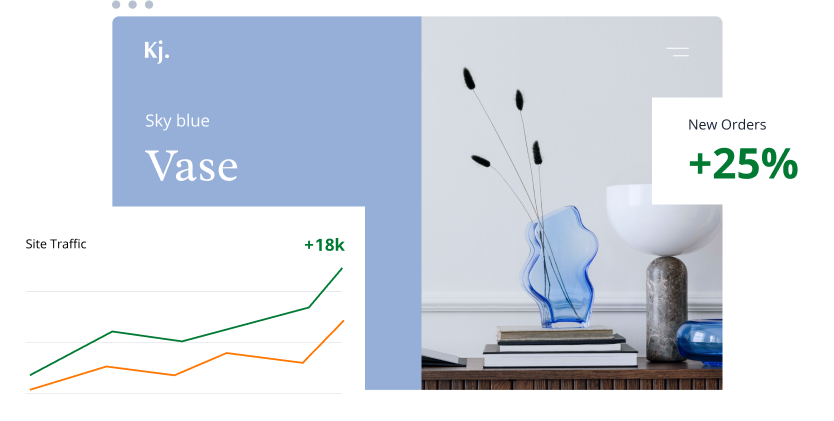Domain forwarding
Drive all your traffic to your main web page
Domain forwarding allows you to easily redirect multiple domain names to a single website, boosting traffic.
$XX.XX /per domain name
*See Offer Details for more information
Offer Details
*Pricing only applies when a 1-year billing term is selected in the cart. Standard annual pricing is available in the cart. This service auto-renews. To cancel, contact us within the time designated to avoid renewal. These prices are subject to change at the sole discretion of Network Solutions.
For additional details see Services Agreement.

Domain Forwarding features

Simple
Type in the primary web address you wish to use for the domain name redirect. We do the rest.

Effective
Send traffic to your primary web address and potentially boost your online brand recognition and increase traffic to your site.

Affordable
Forwarding multiple domain names to a single website is far more economical than creating and maintaining multiple websites.

Ad-free
Network Solutions does not place pop-up ads on your site like other domain name forwarding services.

Smart
Protect your brand by thwarting competitors who want to invade your space.

Versatile
Domain Forwarding ensures branding and marketing consistency, improves user experience, and adds SEO value.
Find the perfect domain
If you don't want to use an existing domain name, search for a new domain.
Bulk Search
Our most popular products
For over 40 years, we've helped professionals like you succeed online. Access industry-leading expertise and world-class tools today.
Why Network Solutions?
Established
in 1979
World’s 1st
domain registrar
Trusted by Fortune
500 companies
Live technical
support
Frequently asked questions
Domain forwarding, also known as domain redirection or URL forwarding, is a service that automatically sends visitors from one domain name to another. Essentially, when someone types in your domain name, they are redirected to a different website.
Domain forwarding works by redirecting traffic from one domain to another. To set it up, log into your domain registrar’s control panel and select the domain you want to forward. For example, if you want visitors typing yoursite2.com to go to yoursite1.com, you will select yoursite2.com and enter the destination URL. Once the forwarding is activated, anyone visiting yoursite2.com will automatically be redirected to yoursite1.com.
Domain forwarding offers several advantages:
- It prevents competitors from using similar domain names.
- It captures traffic from different domain variations.
- It consolidates multiple domains into one site.
- It can help transfer SEO value to your main website if implemented using a 301 redirect, which tells search engines that the move is permanent.
- It seamlessly redirects visitors to your main site.
You should consider forwarding your domain if:
- You’re transitioning to a new domain and want to redirect traffic from the old one.
- You want to consolidate multiple domains to a single website.
- You’re running promotions and need to point to a specific landing page.
- You own common misspellings of your domain and want to redirect them to the main site.
- You want to link directly to your social media accounts or external pages.
The two most common types of redirects are 301 (permanent) and 302 (temporary). A 301 redirect signals to search engines that the website has moved permanently. It’s often used when you’ve changed your domain name or permanently moved your content. This type of redirect passes most of the original site’s SEO value to the new domain.
Meanwhile, a 302 redirect indicates that the move is temporary, and the original URL will be used again later. Since the move isn’t permanent, search engines won’t transfer SEO value as they would with a 301 redirect.
A 301 redirect is typically the best and safest choice, especially if you’re permanently moving your website or consolidating multiple domains to one. It helps transfer SEO value, meaning the search engine rankings and traffic of the old domain are passed on to the new site.
Yes, you can forward multiple domains (including different TLDs or variations) to a single website. Forwarding multiple domain names to a single destination, or merging domains, actually consolidates your online presence and also simplifies domain portfolio management.
Yes, you can forward a domain to an HTTPS website. Domain forwarding works with both HTTP and HTTPS destinations, but for secure redirection, it’s important that the destination website has a valid SSL certificate.
Yes, domain forwarding can affect your SEO—positively or negatively—depending on how it’s implemented. If domain forwarding is set up using a 301 redirect, search engines like Google understand that your domain has moved permanently. This allows them to transfer most of the SEO value (such as backlinks, authority, and rankings) from the old domain to the new one to help preserve your site’s visibility in search results.
On the other hand, if the domain forwarding uses a 302 redirect or is configured incorrectly (e.g., causing redirect loops or not forwarding to the correct canonical version), it can confuse search engines and hurt your rankings.
Domain forwarding automatically sends visitors from one site to another. Conversely, domain pointing refers to the process of updating the domain’s Domain Name System (DNS) records to direct it to the server where a website is hosted. Domain pointing, however, doesn’t send traffic to a specific URL. It simply makes sure that your domain displays the correct website.


